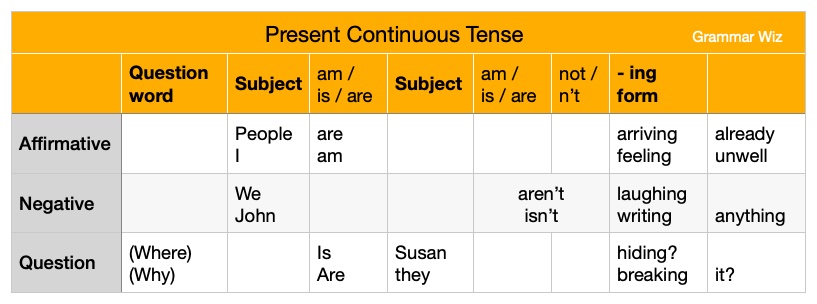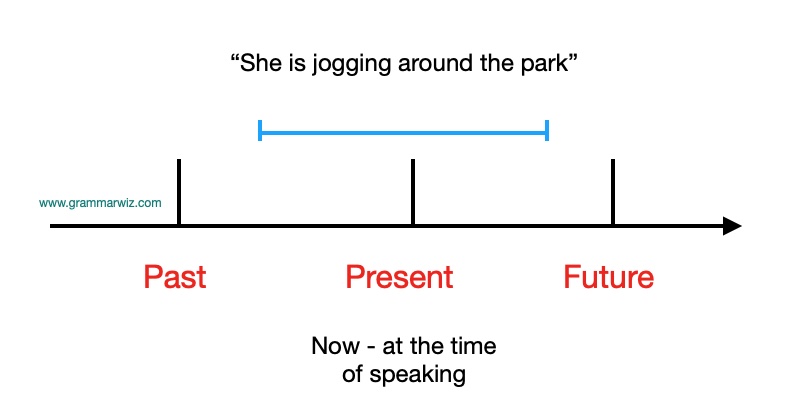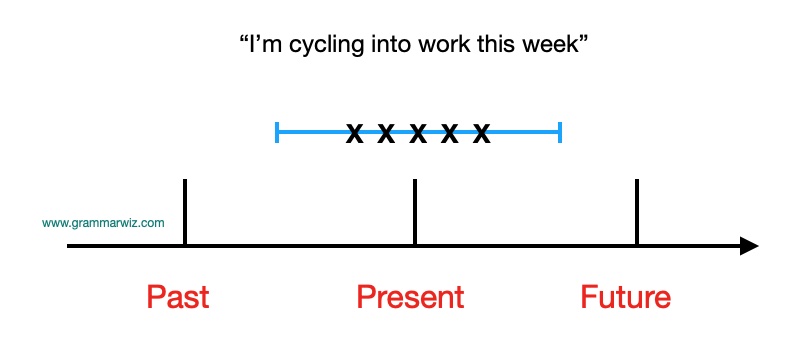Present Continuous Tense with Examples
Here you'll learn about the present continuous tense with examples. This tense is also known as the present progressive.
We'll look at how the tense is formed and when it is used.
Forming the Present Continuous Tense
We form the present continuous tense by using the present tense of 'to be' (i.e. am, is, are) and then adding '-ing' to the verb.
- I'm feeling tired today
The different forms are illustrated in the table below. For the question form, 'to be' is placed at the beginning or after the question word (e.g. where, when etc) if one is being used.
When do we use the Present Continuous Tense?
Temporary Events and Actions
The main use of the present continuous tense is to refer to temporary events and actions.
This means something that has begun but has not finished or is in the process of being completed. What is important is that the event or action is occurring for a limited period of time, which includes the moment of speaking.
This can be shown by this present continuous tense timeline:
Examples of temporary events/actions:
- I'm eating lasagna
- She's swimming the fastest
- They're not taking the news very well
- Why are you looking at me like that?
- Are you speaking to me?
- Where are you living now?
Events or actions can also be intermittent and repeated, and not necessarily occurring at the time of speaking. An example of this is shown in the timeline below - the cycling to work is temporary (for one week) but is repeated each day over 5 days.
Examples of repeated or intermittent events:
- I'm making sure I finish my homework by 5pm
- He's getting up early this week
- She's not having packed lunches anymore
It's wrong though to think that we only use the present continuous tense for things happening now. We'll now look at some other situations for which we can use the present continuous tense with examples.
Changing and Developing States
We also use the present continuous tense for changing or developing states, with verbs such as:
- develop
- expand
- grow
- become
- decline
- improve
We use this tense even though the state may not be viewed as being temporary.
Examples of developing/changing states:
- Some languages are gradually dying out.
- I'm becoming more confident
- Levels of grammar in children are declining
- The town is expanding towards the east
Habitual Action
For things that we do on a regular basis we use the present simple (e.g. I play football every weekend).
But with certain time expressions, we can also use the present continuous. For example:
- always
- continually
- forever
- all the time
- constantly
The present continuous is used to emphasise the repetitiveness of an action, and sometimes the fact that it is irritating.
Examples of habitual actions:
- He's constantly asking me to go for a drink (this is irritating her)
- The government is always changing its policies
- John is forever saying he's going to travel the world one day
State Verbs
Though the grammar rule is generally that the present continuous tense is not used with state verbs, we can use it to express desires, mental states, senses and appearances.
Using it in this way emphasises the temporary nature of the particular state.
Examples of state verbs in the present continuous:
- Is she wanting to come with us?
- Wait, I'm thinking what to do.
- My new house is great. I'm loving living there.
These are not things that are always true (present simple). They are temporary situations. The 'wanting to come' is temporary and will not last forever. And although the person is loving living in their house, that could change.
Talking about the future
We can also use the present continuous tense to talk about the future. There is often a time phrase in the sentence, or in the question.
Examples of present continuous for the future:
- The train is departing at 6.45 pm
- Q: What are you doing tonight? A: I'm meeting a friend.
- I'm taking my driving test next week.
- She's arriving tomorrow
New! Comments
Any questions or comments about the grammar discussed on this page?
Post your comment here.















